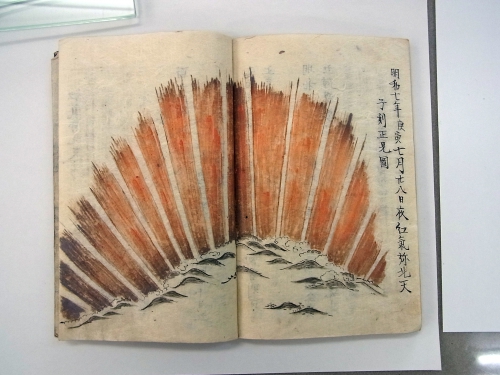The fascination of historical research on auroras opened up by collaboration between the humanities and the sciences

Iwahashi Kiyomi
Associate Professor, Center for Collaborative Research on Pre-modern Texts, National
Institute of Japanese Literature
On 6 September 2017 a solar flare of the most powerful X-class was observed, and the possibility that an aurora might be visible even in Japan around Hokkaido became a hot topic. Auroras are normally visible only at high latitudes in the vicinity of the Arctic or Antarctic, but when powerful solar flares erupt a rare aurora can be seen even at lower latitudes. In fact, perusing back through history, there were a number of occasions when red auroras spread over the night sky in Japan.
In an interdisciplinary research project conducted from 2015 to 2017 by The Graduate University for Advanced Studies (SOKENDAI) on the “Northern lights and human society: Past, present, and future”, led by Kataoka Ryūhō, Associate Professor of the National Institute of Polar Research, historic records of aurora observations were collected and analyzed for the past 2,000 years using Japanese classic texts and ancient documents, and also Chinese historic texts. At present, this research has been taken over by a SOKENDAI joint research project titled “Changes of natural disasters and human society: the way of words and the way of the world” and a large-scale pioneering project spearheaded by the National Institute of Japanese Literature designated the “Project to build an international collaborative research network for pre-modern Japanese texts,” and is in the process of expanding towards research on extreme space weather events.
The most intriguing aspect of historic research on auroras is the impossibility of pursuing the topic without the cooperation of researchers in both the sciences and the humanities. Two events we focused on in particular were the auroras of 21 February 1204 and 17 September 1770. The former is documented in Meigetsuki, a diary kept by Fujiwara no Sadaie, and is already well known in the field of astronomy. However, from a comparison of solar activity traces left in tree ring data (※1) and the frequency patterns of prolonged auroras (※2), we reconfirmed that prolonged auroras occur at times of increased solar activity, and are not witnessed during periods of diminished solar activity over long intervals. Further, in reading the Meigetsuki passage for this analysis, we noticed that the aurora was described with an expression that repeated a Chinese character (kanji) meaning “strange” or “mysterious,” not seen in descriptions of other astronomical events. This subtle difference in expression may be an indication that Sadaie the poet also had an eye for scientific observation.
For the 1770 aurora, while its existence had been previously known, once our research began more than 100 items of related historical documents turned up, far exceeding expectations. Among them are drawings, and one of these is an aurora depicted in Seikai, a handbook on comets. Said to have been seen in Kyoto, the aurora is depicted as spreading in fan-shaped fashion from the ridgeline of mountains (see the figure below). This novel depiction has raised doubts that it really was the image of an aurora. But reconstructing the night sky for the same date based on a description in a diary handed down at the Azumamaro Shrine, also in Kyoto, resulted in the same fan-shaped aurora as pictured in Seikai. Further detailed investigations revealed that the magnetic storm of 1770 could have been on an equal or perhaps greater scale than that of the Carrington Event (※3), said to be the largest ever observed historically.
At the same time, the results of this analysis show that people of the Edo period tried to relate accurately the occurrences of auroras in pictures and writings. The subtle expression through shades of darker and lighter red for variations in the light of auroras requires the power of science to interpret. What science will reveal will give greater richness to the interpretation of historical materials, and provide historians hints for discovering new perspectives that will help understand the awareness of auroras and astronomical observations among people of the Edo period. Does not historical research on auroras thus suggest possibilities for a new field of study, to be opened through collaborative research between the humanities and the sciences?

An aurora depicted in Seikai (courtesy of Matsusaka City, Mie Prefecture)
※1 This refers to levels of 14C measured in the tree rings of Yakusugi (Japanese cedars on the island of Yakushima aged over 2,000 years) for which precise calendar ages of individual rings can be determined, from which past solar activity can be read over an extended period.
※2 The term prolonged aurora refers to one observed over at least two or three successive days.
※3 A magnetic storm observed by British astronomer Richard Carrington in 1859, which was so powerful it caused failures in telegraph systems in Europe and North America.
